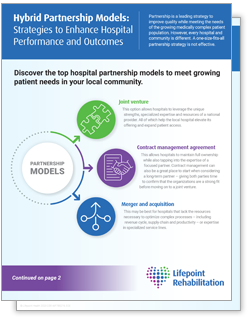|
Partnership has become a leading strategy to efficiently improve quality while meeting the needs of the growing medically complex patient population. However, every hospital and community is different, and a one-size-fits-all partnership strategy is not effective. Read this infographic to discover hospital partnership models and structures that can effectively meet growing patient needs in your community. |
Partnership models
|
Joint venture: This option allows hospitals to leverage the unique strengths, specialized expertise and resources of a national provider. All of which help the local hospital elevate its offering and expand patient access. |
|
|
Contract management agreement: This allows hospitals to maintain full ownership while also tapping into the expertise of a focused partner. Contract management can also be a great place to start when considering a long-term partner – giving both parties time to confirm that the organizations are a strong fit before moving on to a joint venture. |
|
|
Merger and acquisition: This may be best for hospitals that lack the resources necessary to optimize complex processes – including revenue cycle, supply chain and productivity – or expertise in specialized service lines. |
Partnership models
Partnership often leads to service expansion to meet the needs of the local community. But expansion can mean a variety of things and does not require extensive capital.
Three partnership structures to compound with the above models include:
|
Hospital-in-hospital (HiH): An HiH is a separate hospital that is located within the four walls of another hospital, or in one or more distinct buildings located on the same campus. The HiH, or co-location model, can mitigate the risk and challenges of high-risk patient transfers, and reduce length of stay by providing advanced care under one roof from multiple specialties. |
|
|
Specialized care unit: A hospital unit is equipped with specialized resources, such as 24/7 physician oversight, registered nurses that specialized in treating complex patient needs and an interdisciplinary care team. Offering a specialized unit helps maintain care continuity, keeps patients within the hospital’s care continuum and minimizes transfers. |
|
|
Freestanding hospital: This method increases bed capacity and relieves strain on existing hospital resources. It also allows patients to receive timely care in a hospital specifically trained and designed to meet their unique needs. Adding a freestanding specialty hospital can substantially help expand community access to needed services. |
Contact us to find our which partnership model can most benefit your patients and hospital.
You also may be interested in: Rehabilitation Staffing: 5 Advantages of Strategic Partnership


